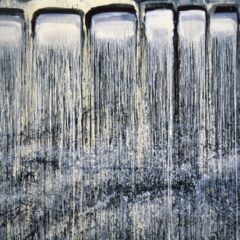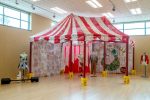Libby and I are suckers for a hard hat tour — especially one of a retrofitted building with a history (like the PMA’s Perelman Building — a former Insurance Company office now used as exhibition and conservation space by the museum. see posts here and here).
So when the invitation came from the Please Touch Museum, we signed right up.
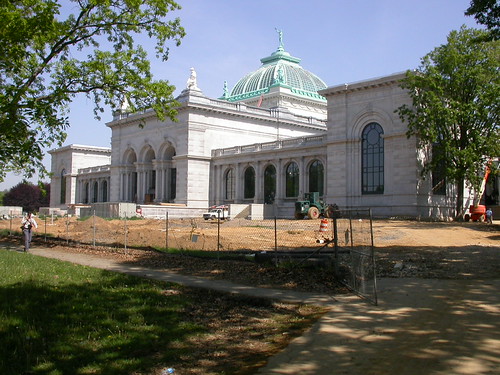
Memorial Hall, Fairmount Park, under re-construction for the Please Touch Museum which will open there in October this year.
Please Touch, Philadelphia’s Children’s Museum, is moving into a spectacular Victorian-era building, Memorial Hall, situated in Fairmount Park. Since PT announced that siting several years ago I’ve wondered how the grand old building and the children’s interactive exhibits would marry one to the other. After our tour, I’m convinced — it’ll be great, lots of fun and entertainment and a solid Philadelphia history lesson too.
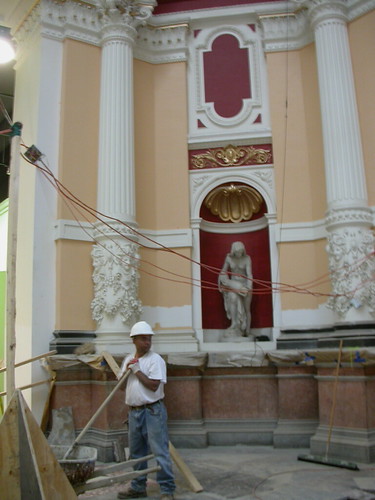
Beautiful center hall under the 60-ft high dome which is under a 150-ft tall copper roof.
Memorial Hall’s space with its ultra high ceilings and grand scale is a wow; the restoration is being done lovingly and in the spirit in which the building was created (to be a grand promenade and a time away from the everyday world to look and learn new things). Dusty shades of pink, green and peach adorn the enormously-high walls; woodwork and plaster are being restored; new windows are in keeping with the scale and time period of the building. The building and the history it tells about the city will be an eye-opener to many who’ve often wondered what Memorial Hall is and why it’s there in Fairmount Park.

Skylit central hall with lovely plaster details and nice pale colors. The sculpture (in progress) is by local artist Leo Sewell. It’s the statue of Liberty’s upraised arm and torch. The real Liberty’s arm and torch were on display at the 1876 Centennial.
About Memorial Hall
Memorial Hall was built for the 1876 Centennial, a 6-month long world’s fair celebrating America’s 100th birthday and singing the praises of American innovations and technology. The Hall was built as the Centennial’s art gallery, a venue notorious now for shunning Thomas Eakins‘ 1875 masterpiece The Gross Clinic, a painting considered too violent and bloody for public display (the work was hidden away elsewhere with Army medical exhibits). Even while it rejected Eakins’ works, the Centennial art gallery’s jurors accepted and installed more than 3,000 paintings and drawings, more than 600 sculptures, more than 400 works of applied art and around 3,000 photographs.
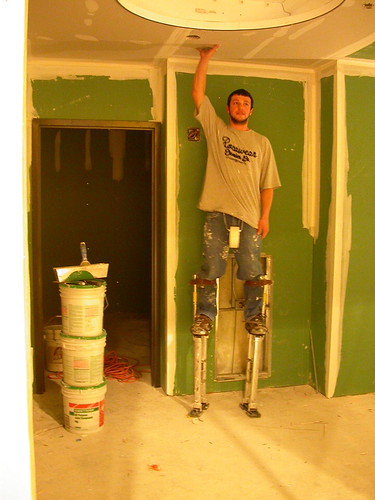
The day we visited, the building was a hive of activity with carpenters, plasterers and others busy at work. Here a worker putting plaster touches on posed for us in his stilts (they have springs in them!) I’d never seen these before but would love to own a pair!
The Beaux-Art style building was designed by Herman J. Schwarzmann to be an art gallery and the home of the Philadelphia Museum of Art. It took almost 3 years to build at a cost of roughly $1.5 million. (Building it from scratch today would cost more than $25 million, according to the press materials.) The exterior is granite; the interior is cast iron and stone finished with ornate plasterwork. The Central Hall is topped by a 150-ft. high dome visible from the Schuylkill Expressway.
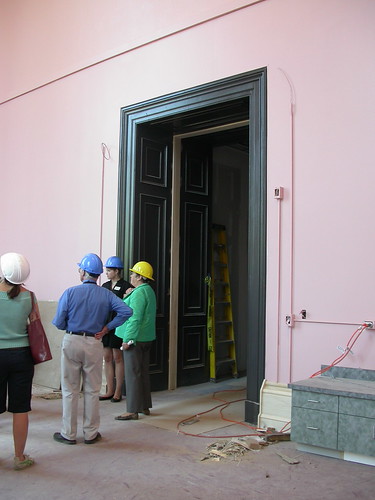
The building’s scale is theatrical, the doorways seemingly for giants.
After the fair, Memorial Hall became the first home of the Pennsylvania Museum and School of Industrial Arts (now PMA) from 1877-1928. After the PMA moved out it retained the building for storage and for small exhibits until 1956 when Memorial Hall was converted to a community recreation center with an indoor swimming pool and basketball courts. It was also home of the Fairmount Park Commission and the Accident Division of the Police Department (there were apparently jail cells even). In 2000 the Park Commission sought new tenants for the deteriorating building, and PT signed up, agreeing to an 80-year lease. The museum will open its doors to the public Sat., Oct. 18, 2008.
About the Centennial Fair
Almost 10-million people visited the fair — the first world fair in the US — this was a huge success. President Ulysses S. Grant presided over the opening, his address followed by a 100-gun artillery salute. There were 60,000 exhibitors and the huge event attracted a side-show “city” with alternative exhibits like a 3-headed cow, a bearded lady and women doing the Can-Can. The American exhibitors were all about showing the newly-invented “American system” of interchangeable parts in manufacturing, something foreign companies were very interested in for its touted cost savings in factory production.
Alexander Graham Bell demonstrated the first telephone at the Fair; Charles Hires, a Philadelphia pharmacist, introduced his beverage Root Beer at the fair; also, 20,000 trees and shrubs were planted on the grounds. And, sadly, Philadelphia experienced a massive heat wave that summer that claimed more than 110 lives in the month of July. The entire lollapalooza cost $8.5 million in 1876. In today’s dollars, a comparable fair would cost more than $141 billion.
When the Fair closed, the exhibits were removed as were most of the buildings. Many of the exhibits went on to be the cornerstones of some major American museums. The Smithsonian acquired exhibits of 34 countries and a number of US states — all of which was transferred to Washington and housed in the Washington Armory.
About the scale model of the Centennial Fair
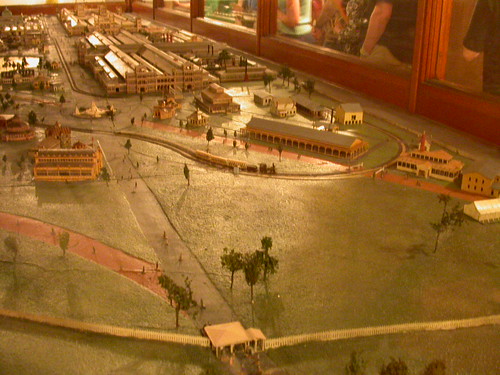
Centennial model, in the Memorial Hall’s basement. The model is encased in glass and the PT museum will have an education program with artifacts to bring the history to life.
Tucked away in the building’s basement is a scale model of the 1876 Centennial. The 1 to 192-scale model, built in the mid-1880s, was commissioned by John Baird, a member of the Centennial Board of Finance and built by local mechanics who carved and painted the buildings and other objects. The model was given by Baird to the city and was displayed in City Hall from 1890-1894. In 1901 it was put in storage in the basement of Memorial Hall. The PT will make the Centennial model a signature part of its programming with artifacts, stories and touchable objects to lead visitors back through time and into the history of the event and the building.
About the Carousel and Carousel House
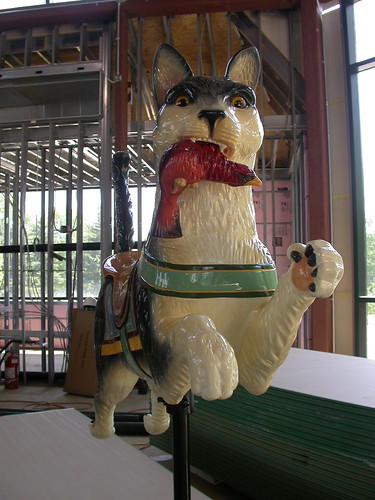
The Carousel House — a 9,000 sq. ft. glass pavilion — is the one addition the PT museum has made to the 365 ft. long, 210 ft. wide, 59 ft. tall Memorial Hall, and the addition will house the 1924 Woodside Park Dentzel Carousel, a ride made in Philadelphia that once was installed in nearby Woodside Park, then belonged to the Smithsonian and has been in storage until 2 years ago when it was offered to PT which happened to be searching for one.
“Some of the best carousels were made in Philadelphia on Germantown Avenue,” Museum President and CEO Nancy Kolb said. The Dentzel Carousel Company’s “Philadelphia style” carousel is a 3-abreast carousel with a stationary outside row of characters. There are 52 carved animals and two chariots; 16 stationary horses; 18 beveled mirrors on the outside; 24 horses, four rabbits, four cats, two pigs and two goats. Right now, the merry-go-round is being restored in Ohio.
Kolb spoke about the museum’s pride at being a big part of the engine of economic development in the Parkside area of the city. She pointed out the nearby School of the Future (part of the Philadelphia School system), also in the park, which would not have chosen its site but for PT’s Memorial Hall move. She also complimented the workers on the project who take great pride in restoring the building. “The original building was built in 3 years and we’ve been working on it for 5,” she said, adding that the original building was considered a model for the German Reichstag in Berlin. The building is on schedule for its October opening, Kolb said.

Greg, one of the catering staff, in hard hat.
I’d never seen a caterer in a hard hat, so I’ll leave you with that. And the thought that I will surely go back to see this museum when it’s open . I’d like to see it without the scaffolding — and with the children.


